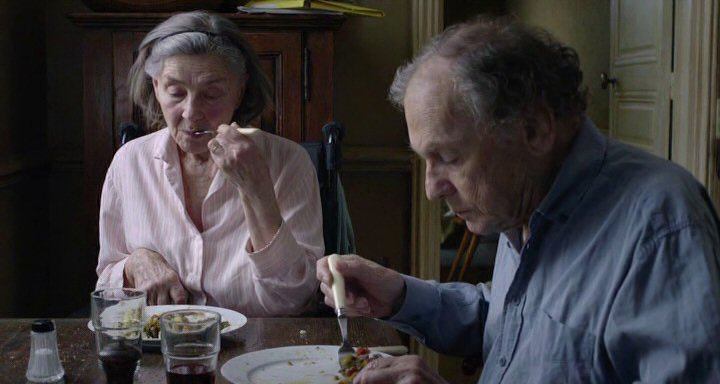The main body of this review was written by Eddie Feng in 2004 regarding the 2003 SD release of the film by New Yorker. The other sections of the review are written by Christopher Long and address the 2013 Blu-ray release by The Criterion Collection.
The Film According to Eddie:
A handful of films dominate the public awareness when it comes to Holocaust films. There’s the black-and-white “The Diary of Anne Frank”, a melodrama that shamelessly manipulates audiences’ emotions instead of letting events speak for themselves. There’s “Anne Frank Remembered”, a documentary that offers the only known motion picture footage of the girl who immortalized herself with a war-time diary. Many Americans saw “Holocaust”, a TV mini-series starring Meryl Streep, during the 1970s. “Life Is Beautiful” mugged and pratfalled its way to a couple of Oscars in 1999. “The Sorrow and the Pity” was a landmark documentary that initiated France’s self-examination of its role in anti-Semitic activity.
The two big ones, though, are Steven Spielberg’s “Schindler’s List” (1993) and Claude Lanzmann’s “Shoah” (1985). Given the outsized dimensions of The Holocaust, it makes sense that both films are lengthy epics (3.25 and 9.5[!] hours, respectively). The movies exist in direct opposition to one another. “Schindler’s List” is a fictionalized account of historical events. “Shoah” (a Hebrew word that means “chaos” or “annihilation”), perhaps taking inspiration from Theodor Adorno’s declaration that there can be no new poetry following The Holocaust, does not have any direct representations of historical occurrences. Lanzmann refused to use archival footage of actual Holocaust victims/environments. Rather, he uses newly-shot interviews with people who witnessed what happened. He visits concentration camps in the present, quiet places now overrun with vegetation. He examines documents that detail how the camps were run.
Since Lanzmann isn’t trying to relate a narrative, he imparts a sense of how The Holocaust continues into the present day. No one is being killed in the Nazis’ death camps any more, but those who suffered through and witnessed The Holocaust can’t leave it behind them in the past. Perpetrators have to hide their identities. Bystanders have to deal with being judged for doing nothing. Survivors either have an extreme sense of guilt for living or are so scarred that they are barely living. The film’s clearest accomplishment is that of noting how history isn’t just a study of the past but of how it continually shapes the present.
Claude Lanzmann once said that, had Spielberg had the proper moral conscience when it comes to the Holocaust, the American director either would not have made “Schindler’s List” or would have made “Shoah” instead of a fictional narrative. Personally, I feel that Lanzmann’s attitude is very restrictive and limiting. We can not understand what we can not see; consequently, there is a remove between what we know and what we feel when confronted with “Shoah.” As everything is talk and diagrams and charts and decayed-remnants-of-the-concentration-camps, it becomes tempting to ask Lanzmann to start showing and to stop telling. Indeed, the irony of “Shoah” is that it has an “objectifying” viewpoint that resembles Nazi bureaucratic coldness since the film does not create the kind of pathos that an re-enactment or archival footage can (for example, the newsreels that American Army soldiers filmed when they first arrived at death camps generates shudders no matter how many times you’ve encountered The Holocaust).
The Film According To Christopher:
I don’t agree with Eddie that Lanzmann isn’t trying to relate a narrative. In fact, he allows the narrative to unfold slowly and in constantly surprising ways; he follows wherever his subjects lead with the vigor of a dogged investigator and the humility of a man who does not claim a privileged understanding. It’s a narrative that offers no sense of closure or arbitrary structure. It simply rolls on and on, constantly opening new chapters, dropping some and pursuing others, providing facts but not answers. Or rather some answers, but many more questions.
However, Eddie is spot on when pointing out that Lanzmann’s film constantly places the Holocaust in the present. Both the survivors and perpetrators reveal stunning accounts in the extensive interviews that form the backbone of the film, but the scene I think on the most occurs in front of a Catholic Church in Poland. Chelmno survivor Simon Srebnik is surrounded by a crowd of Polish townsfolk who put up a sympathetic front to all of Lanzmann’s questions, but the (deceptively) placid scene eventually devolves into anti-Semitic ranting (all with Srebnik smiling patiently) and an asinine story that supposedly provides evidence of Jewish acquiescence to their fate. It’s a reminder of another scene when Polish housewives admit that it’s not so bad not having Jewish women around as romantic competition anymore: they were all so pretty because they didn’t have to work, you see. Lanzmann was so canny in understanding that archival footage would only undermine his portrait of the now.
Video:
The film is presented in its original 1.37:1 aspect ratio. According to the Criterion booklet: “This new digital master was produced from a restoration undertaken in 2012-13 by the Cineteca di Bologna in Italy. The transfer was created in 4K resolution… from the original 16 mm camera negative… the scans were color-corrected… under the supervision of Caroline Champetier, who served as assistant camera person on ‘Shoah.’” The color correction provides a major upgrade from the previous SD release which looked rather wan and had a slightly greenish pall. Image detail in the high-def upgrade is much sharper, though the 16 mm source limits the resolution a bit. There’s virtually no damage or distortion evident. I don’t know how much boosting was required to produce such a clean image, but this restored high-def transfer is impressive work.
Audio:
The linear PCM Mono sound track is crisp and distortion free. There are many languages spoken in the film. Lanzmann speaks French, German, and English. Their dialogue is subtitled with optional English subtitles. For subjects who spoke other languages (Hebrew, Yiddish, Polish, etc.) Lanzmann employed translators, and subtitles are only provided when the translator relates what has just been said in French.
Extras:
Criterion has assembled an absolutely overwhelming three-disc collection. The first two discs include the film in its four parts. Disc One has First Era, Part One (154 min.) and First Era, Part Two (121 min.) . Disc Two has Second Era, Part One (146 min.) and Second Era, Part Two (147 min.)
Disc Three packs in the substantial collection of extras. Claude Lanzmann has released four subsequent films comprised of footage shot during the lengthy filming of “Shoah.” Three of them are included here.
“A Visitor From The Living” (1999, 68 min.) is an interview with Maurice Rossel, a Red Cross. Lanzmann chose to leave this interview out of “Shoah” because he felt it deserved its own treatment and he was certainly correct. When Rossel gave him permission to use this material for the 1999 film, he asked the director not to make him look too ridiculous. Lanzmann states bluntly, “I did not try to.”
In 1944, the 25 y.o. Rossel was sent by the Red Cross to investigate Theresienstadt, the “model ghetto” set up by the Nazis to show the world that the Jews were being treated well. Located fifty miles outside of Prague, Theresienstadt was a concentration camp where thousands of Jews died and many more were transported from there to other execution sites. But the camp was gussied up by the Nazis (with a band and a playground even) for Rossel’s visit, and he reported back that life there “was almost like a normal town.” The interview took place in 1979 and Rossel already claims the events were so long ago, he “can’t be precise,” but it’s obvious his forgetfulness is both willful and convenient. Lanzmann is patient enough when Rossel contradicts himself, but when Rossel shares his surprise and disapproval at how “passive” the Jews he saw were, clearly placing blame on their shoulders, Lanzmann replies with a furious volley of evidence about the grim conditions Rossel somehow didn’t see. Theresienstadt actually doesn’t come up until the second half of the interview; the first half provides Rossel a chance to brag a bit about how he talked his way into a brief investigation at Auschwitz.
“Sobibor, October 14, 1943, 4 PM” (2001, 102 min.) is also comprised of footage shot during the production of “Shoah.” The interview subject is Yehuda Lerner, who, at the age of 16, helped lead the uprising at the Sobibor extermination camp in eastern Poland. Lerner had already escaped from several camps before being shipped to Sobibor and wasted little time on his next escape plan. His detailed and vivid recounting of the events is absolutely riveting, and Lanzmann matches audio with new (2001 or so) footage in the locations being discussed. The film is an explicit response to people like Maurice Rossel who accuse Jewish victims of not putting off sufficient resistance to their murderers.
“The Karski Report” (2010, 49 min.) places Jan Karski at center stage. Some of his interview appears in “Shoah,” but this is a greatly expanded version. Karski was a resistance fighter and an undercover agent who witnessed events at the Warsaw Ghetto and at extermination camps and reported this information to officials from other governments. This interview focuses mostly on Karski’s account of how his report was received in America. He is a very melodramatic performer which adds a vibrant and even occasionally humorous touch to his story. He speaks of his meeting with President Roosevelt and later of a remarkable encounter with Supreme Court Justice Felix Frankfurter who simply was incapable of believing what he had heard. It’s absolutely mesmerizing.
Disc Three also includes two interviews with Lanzmann: a 2013 interview conducted by Serge Toubiana (61 min.), and a 2003 interview by Helene Frappat (14 min.) in which the director talks about “A Visitor From the Living” and “Sobibor.”
The final extra on the disc is a January 2013 interview (33 min.) with cinematographer Caroline Champetier and director Arnaud Desplechin. Champetier was an assistant camera operator on “Shoah” and supervised the color correction on this new restoration of the film.
Criterion has produced a very impressive square-bound insert booklet that runs 60 pages. The first 25 pages consist of still shots marking each “chapter” of the four parts of the film, naming the subject who is interviewed and providing a brief capsule of what they discuss. “Shoah” is an overwhelming experience even if viewed over several days, and this kind of visual-text guide is very helpful. After that the booklet includes a one-page statement by Lanzmann, followed by an extensive essay by critic Kent Jones who does his usual fantastic job. After Jones’s essay, we get Lanzmann’s essay “From the Holocaust to ‘Holocaust.’” Published in 1979, it addresses the hit miniseries “The Holocaust” and how it fails to address its historical subject.
Film Value:
I’m hesitant to call anything a “definitive” release of “Shoah,” but Criterion has certainly vastly improved on anything previously available. The high-def transfer from the recent restoration is a major upgrade, and the inclusion of three other Lanzmann films taken from “Shoah” footage makes this set as close to comprehensive as possible. “Shoah” has fueled many critical debates over the years about the “appropriate” way to treat the Holocaust in the medium of cinema. I am not foolish enough to claim to be an authority on the subject. I do know that “Shoah” is a draining, overwhelming experience that nobody is ever likely to forget. And I do feel qualified to say that this is one of the most important Criterion releases of the year, and a collection that does justice both to the film and its director.


